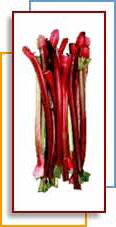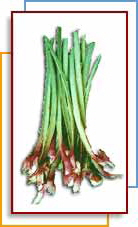Home | FOOD ARTICLES | Food Trivia | Today_in_Food_History | Food_History_Timeline | Recipes | Cooking_Tips | Food_Videos | Food_Quotes | Who’s_Who | Culinary_Schools_&_Tours | Food_Trivia_Quizzes | Food_Poems | Free_Magazines | Food_Festivals_and_Events
Food Articles, News & Features Section
FREE Magazines
and other Publications
Free Professional and Technical Research, White Papers, Case Studies, Magazines, and eBooks
RHUBARB
See Also: Rhubarb Trivia - Rhubarb Kitchen Tips
Rhubarb is a relative of buckwheat and has an earthy, sour flavor. Rhubarb thrives in cold climates and originated in Western China, Tibet, Mongolia, Siberia and neighboring areas. The traditional role was medicinal-the dried root was a popular remedy for a wide range of illnesses. Its primary function was to induce vomiting, although rhubarb is also a mild astringent. This medicinal role caused the price of the dried root to rise. In 1542, rhubarb sold for ten times the price of cinnamon in France and in 1657 rhubarb sold for over twice the price of opium in England (Schneider, 2001). Beginning in the eighteenth century, rhubarb began to be consumed in foods, primarily drinks and meat stews. Botanically speaking, rhubarb is considered a vegetable, but it's most often treated as a fruit — though it's rarely eaten raw. Just like fresh cranberries, rhubarb is almost unbearably tart on its own and needs the sweetness of sugar, honey, or fruit juice added to it to balance out the acidity. Rhubarb's nickname is the "pie plant" because that is the primary use for this vegetable.
Botanically speaking, rhubarb is considered a vegetable, but it's most often treated as a fruit — though it's rarely eaten raw. Just like fresh cranberries, rhubarb is almost unbearably tart on its own and needs the sweetness of sugar, honey, or fruit juice added to it to balance out the acidity. Rhubarb's nickname is the "pie plant" because that is the primary use for this vegetable.
Rhubarb was introduced to the United States at the end of the eighteenth century. Today most rhubarb is frozen for commercial and institutional use; only about a quarter of the crop is sold fresh.

SELECTION
Hothouse, or strawberry, rhubarb appears in markets as early as January and continues to be stocked through April. Field-grown, or cherry, rhubarb begins to arrive in markets in March and can continue to arrive through the summer (depending on the area where it is grown). Spring stalks are the juiciest and most-tender.
Fresh stalks are flat, not curled or limp. When stalks that have been pulled-not cut-from the field are available; choose them. Pulled stalks dry out less rapidly. Size is no indicator of tenderness. Deep red stalks are sweeter and richer.
STORAGE
Wrap rhubarb in plastic wrap and store it in the coldest part of the refrigerator for up to one week. Cooked and raw rhubarb both freeze well.
PREPARATION
Cut off and discard and leaves (see warning). Rinse and trim from base and tip. You may peel or cut with the skin intact. Remember to cook only in non-aluminum pots only due to the acidic nature of rhubarb.
WARNING
Never eat rhubarb leaves, cooked or raw. Eating the leaves can be poisonous because they contain oxalate. This toxin, plus another unknown toxin also found in the leaves, has been reported to cause poisoning when large quantities of raw or cooked leaves are ingested.

VARIETIES
Green varieties: Riverside Giant, a cold-hardy, vigorous producer with large diameter, long, green stalks.
Red stalk types: Crimson (may also be called Crimson Cherry, Crimson Red, or Crimson Wine). It produces brightly colored red stalks with the unique characteristic of being red throughout under normal temperature and moisture conditions of the Pacific Northwest. Other vigorous red varieties are Valentine and Cherry Red (Cherry, Early Cherry), producing long, thick, deep-red stalks.
Speckled types (pink): Victoria produces large stalks of excellent quality, long, round with smooth ribs. It develops pink speckling on a light green stalk with the pink color being more intense at the bottom of the stalk, fading to a solid green near the top. Victoria is commonly used for forcing.
Strawberry is very similar to Victoria, and may be the same variety. MacDonald is another "pink" type that produces well.
German Wine is similar to Victoria but slightly more vigorous and more intense in color, typically with a darker pink speckling on a green stem.

Make Rhubarb Part of Your 5 A Day Plan
* Add rhubarb to your favorite pie or fruit bread.
* Add cooked rhubarb into a fruit topping for poultry
* Top frozen yogurt with berries and rhubarb-adds a twist!
RELATED ARTICLES
Please feel free to link to any pages of FoodReference.com from your website.
For permission to use any of this content please E-mail: james@foodreference.com
All contents are copyright © 1990 - 2025 James T. Ehler and www.FoodReference.com unless otherwise noted. All rights reserved.
You may copy and use portions of this website for non-commercial, personal use only.
Any other use of these materials without prior written authorization is not very nice and violates the copyright.
Please take the time to request permission.

